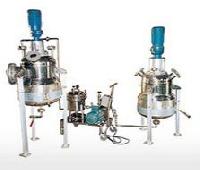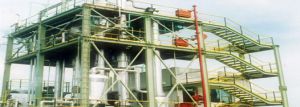






forced circulation evaporator
Get Price Quote
Circulation evaporators are a type of evaporating unit designed to separate mixtures unable to be evaporated by a conventional evaporating unit. Circulation evaporation incorporates the use of both heat exchangers and flash separation units in conjunction with circulation of the solvent in order to remove liquid mixtures without conventional boiling. These type of evaporators some mechanical device are fitted to circulate the contents heating in it. For example an evaporating pan in which the materials is agitated by a stirring rod or by a mechanical propeller. The liquid is circulated by means of a pump and as it is under pressure in the tubes the boiling point is raised and no boling take places. And it enters the body of the evaporator.

forced circulation evaporator
Get Price Quote
Mazda Forced Circulation Evaporators are recommended for the concentration of high viscocity solutionsslurries having tendency to crystallize or produce scales.Advantages:Ideal for high crystallizing and high viscosity solutions & slurries,High operational flexibility, heat transfer co-effecients, vapour liquid separation.
Best Deals from Forced Circulation Evaporator

forced circulation evaporator
Get Price Quote
Evaporation is the process, which involves thermally removing a liquid from a solution, suspension or emulsion. The starting and the end products are in the liquid phase and the end product obtained is in its concentrated from. forced circulation evaporatorDepending on the liquid characteristics to be concentrated, its temperature sensitivity, thermal degradation properties etc different types of evaporators have been designed and are used for variety of applications in different industries. Single stage systems are employed, where the vapour energy of one stage is used as the heating media for the next stage. Further efficiency increase is obtained by using Thermal Vapour Recompression system or Mechanical Vapour Recompression system.

forced circulation evaporator
Get Price Quote
Evaporation is the process, which involves thermally removing a liquid from a solution, suspension or emulsion. The starting and the end products are in the liquid phase and the end product obtained is in its concentrated from. Depending on the liquid characteristics to be concentrated, its temperature sensitivity, thermal degradation properties etc different types of evaporators have been designed and are used for variety of applications in different industries. Single stage systems are employed, where the vapour energy of one stage is used as the heating media for the next stage. Further efficiency increase is obtained by using Thermal Vapour Recompression system or Mechanical Vapour Recompression system. Forced Circulation Evaporator These could be horizontal or vertical. The fluid is forced under pressure through the tubes and are useful in handling slurries too. APPLICATIONS OF FORCED CIRCULATION EVAPORATORS Milk concentrate from 8 - 10% upto 45% Effluent concentrate before incineration Weak liquor low temperature concentration Dilute Caustic lye solution concentration Herbal extract concentration Fruit juice concentration

Forced Circulations Evaporators
Get Price Quote
Chem Process’ Forced Circulation Evaporators are normally used for liquids which are prone to fouling, scaling, crystallizing or for those which are inversely soluble or while concentrating thermally de-gradable materials. Here high re-circulation rate allows high liquor velocities through the tubes which help to minimize the buildup of deposits or crystals along the heating surface. The universal type, preferably used for concentration of solutions containing encrusting substances, hardening agents and un-dissolved solids, and for viscose solutions; also suitable for evaporative crystallization. Forced circulation is required when hydrostatic head prevents boiling at the heating surface. A pump can also be used to avoid fouling that is caused by the boiling of liquid on the tubes; the pump suppresses bubble formation. Other problems are that the residing time is undefined and the consumption of steam is very high, but at high temperatures, good circulation is easily achieved. How it works Liquid is circulated at a high rate through the heat exchanger, boiling being prevented within the unit by virtue of a hydrostatic head maintained above the top tube plate. As the liquid enters the separator where the absolute pressure is slightly less than in the tube bundle, the liquid flashes to form vapour.